If you were to stroll through West London’s Brompton Cemetery, you’d notice that – above the gothic tombs, the Celtic crosses, the ivy-strangled gravestones – there looms a strange and imposing mausoleum. By far the graveyard’s largest, this house of death rises up from its own circle of land, a circle positioned at a crossroads of cemetery paths – a circle that seems a psychic and symbolic central point.
Intrigued by how the tomb towers over the other grave markers, you might move closer and observe its Neo-Egyptian design. You might suspect this mausoleum has generated legends. Coming closer still, walking up the steps, you’d see the tomb’s huge bronze door bears a band of hieroglyphs. Scarab beetles are prominent – Ancient Egyptian symbols of the defiance of death and time and the embrace of the eternal.
You’d be right to think this mausoleum has become a node of London legend, a focus for urban myths, a nexus of the most incredible folklore. Some believe the tomb contains a working time machine or teleportation device, cobbled together by an eccentric Victorian inventor with the help of an Egyptologist who’d discovered scientific secrets while decoding hieroglyphs on the walls of tombs or carved into sarcophagi.
The tomb is the resting place of Hannah Courtoy – a wealthy London heiress obsessed with Ancient Egypt – and her two spinster daughters. The men responsible for the time machine the Courtoys allegedly share their mausoleum with also lie in Brompton Cemetery. Just a few metres from the Courtoy tomb is the grave of the Egyptologist Joseph Bonomi, his headstone carved with a depiction of the jackal-headed god Anubis. And near the graves of Bonomi and Courtoy – in an unmarked plot – lies Samuel Alfred Warner, an idiosyncratic inventor whose ideas for ‘teleporting torpedoes’ so interested the British Navy they allowed him to blow up boats in the English Channel.
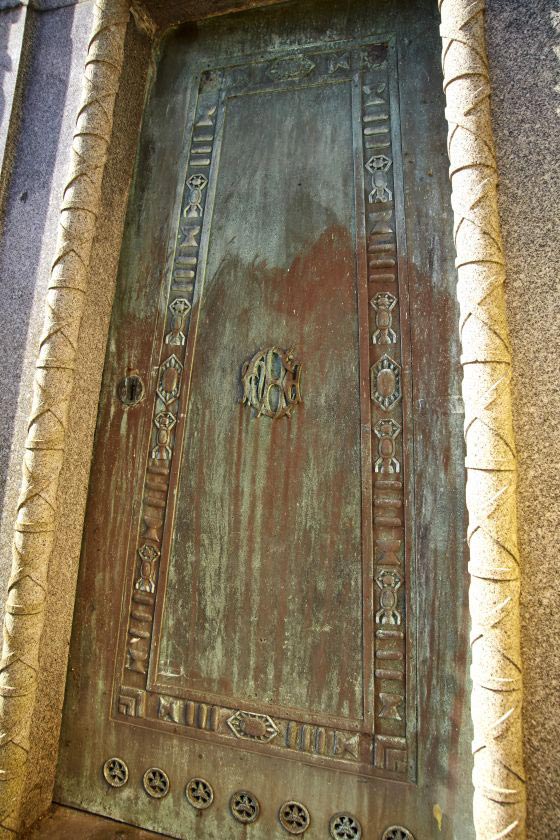
The hieroglyph-inscribed door of the Neo-Egyptian Courtoy tomb, Brompton Cemetery, London – note the scarab beetles, symbolising victory over death. (Photo: Royal Parks)
But what were the connections between Hannah Courtoy, Joseph Bonomi and Samuel Warner? How did Hannah come by the immense wealth needed to build such a spectacular tomb? Could there be any truth in the legend that a time machine lurks in the Courtoy mausoleum? And might Hannah Courtoy, her daughters, Bonomi and Warner still be zipping through time and space today, having cheated aging and death and just occasionally returning to their Brompton Cemetery base?
Keep reading for tales of disagreeable French wigmakers, knife-armed prostitutes, bitterly contested wills, murders undertaken to protect national security, and secret teleportation passages to other London Victorian graveyards and even Paris cemeteries.
Hannah Courtoy’s Tomb in London’s Brompton Cemetery
Brompton Cemetery is one of London’s so-called Magnificent Seven – the ring of large Victorian graveyards built in the countryside on the then-outskirts of the capital to relieve pressure on the rapidly growing city’s gruesomely overcrowded churchyards and burial grounds. Kensal Green Cemetery opened in 1833 while the highly gothic West Norwood Cemetery was accepting burials by 1837. Highgate Cemetery opened in 1839; Abney Park, Nunhead and Brompton Cemeteries were in business by 1840; and Tower Hamlets Cemetery opened in 1841.
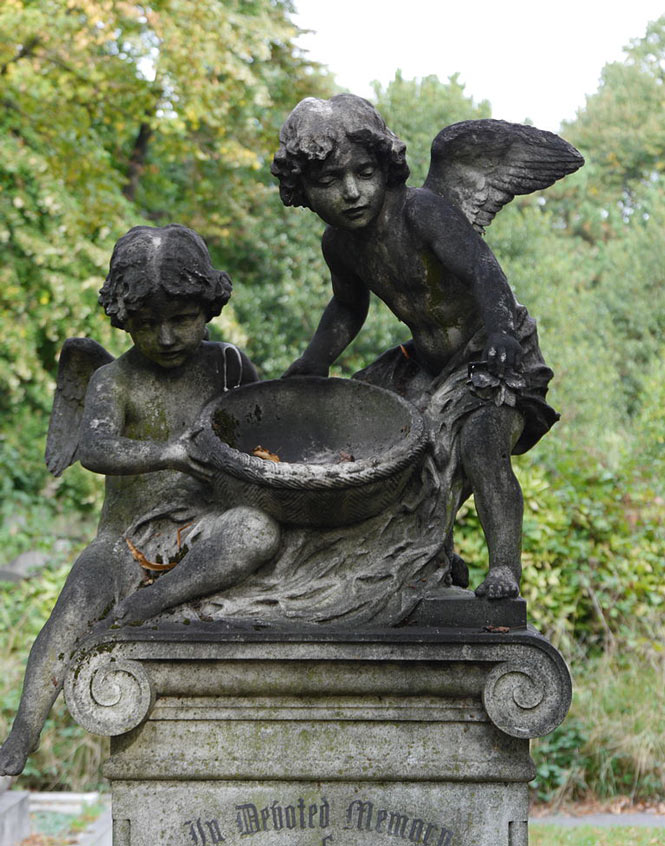
Victorian angels in Brompton Cemetery, London. (Photo: Edwardx)
These graveyards – with typical Victorian enthusiasm – were grandly laid out, with vast gates, long tree-shaded avenues, landscaped grounds and elaborate networks of catacombs. Much of the design drew inspiration from ancient civilisations and earlier epochs. Highgate Cemetery boasts an imposing Egyptian-style gate leading into the Egyptian Avenue while the padlocked doors to Brompton Cemetery’s extensive catacombs are emblazoned with the age-old occult symbol of snakes curling around staffs. In both Brompton and Highgate, urns are kept in buildings known as Columbariums, a custom which draws from Roman mortuary practices. Brompton was planned in the form of an enormous outdoor cathedral, in the style of Rome’s St Peter’s Square and Basilica, with its ‘nave’ running from Old Brompton Road towards the central colonnade and chapel. The cemetery was luxuriantly planted with shrubs and trees. Ornate graves and mausoleums – ranging from pseudo-gothic chapels and Arts-and-Crafts faux-medieval reliquaries to Egyptian-style obelisks (symbolic of the sun god Ra) – have added to Brompton Cemetery’s gloomy yet appealing grandeur.
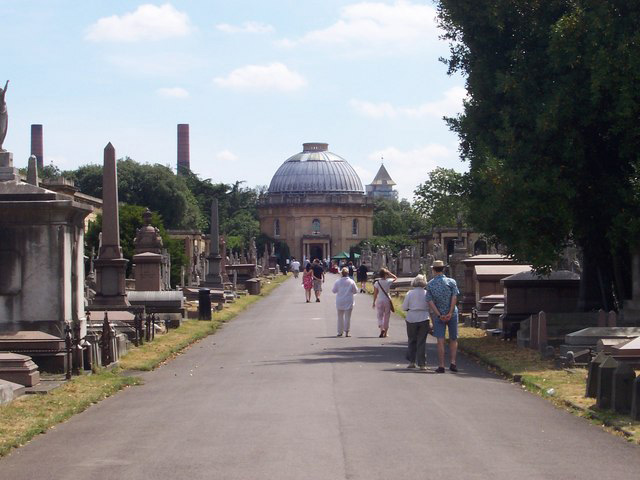
The Main Avenue in Brompton Cemetery, looking towards the chapel. Note the Neo-Egyptian obelisks. (Photo: Russell Trebor)
Those buried at Brompton include the suffragette Emmeline Pankhurst, John Keats’s muse Fanny Brawne, the founder of the Cunard shipping line Samuel Cunard, and the murdered Victorian actor William Terriss, whose ghost apparently haunts Covent Garden London Underground Station. Beatrix Potter would stroll the cemetery and pick out names from gravestones for her characters – with Peter Rabbett and Mr Nutkins among those chosen. But – out of all the broken pillars and shrouded urns and praying angels and other Victorian memento mori and funerary art – it’s the Courtoy mausoleum that stands out most.
Completed in 1854, the Courtoy tomb is twenty feet tall and made from polished granite. Its bronze door is ornately inscribed with what appear to be Hannah’s initials, H.C. Egyptian hieroglyphs decorate one of its steps and the tops of its walls, as well as a rectangular band on the door. The mausoleum’s crowned with a structure resembling a stepped pyramid and attractive Egyptian designs adorn its cornices. One thing that’s perhaps drawn the attention of psychogeographers and occultists is the fact the tomb stands on its own kind of island, its own circle of ground in the middle of a crossroads. Crossroads in folklore are liminal places, with the intersection of two roads suggestive of a spot where different states or dimensions might meet – life and death, this world and the otherworld, perhaps even different eras. Crossroads were for a long time sites of gibbets and gallows. Suicides were buried at these junctions and magical rituals conducted. Crossroads were even viewed as places where – as in the case of the blues musician Robert Johnson – you could approach the Devil to ask a favour.
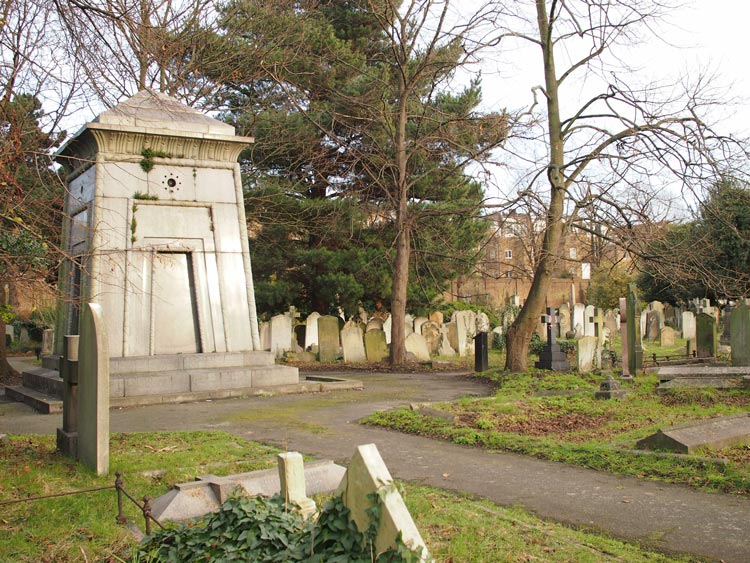
The Courtoy Mausoleum – or Victorian time machine – in London’s Brompton Cemetery. (Photo: Flickering Lamps)
Those with a fondness for the esoteric have also pointed out that – in addition to the hieroglyphs – the tomb bears strange decorations. There are wheel-like motifs at the door’s bottom, which some claim are symbols for – or components of – the time machine. High on the walls, on all four sides of the tomb, are large circular holes. Each of these contain what appears to be a glass orb and each has eight smaller holes in a ring around it. Some say these patterns resemble clocks or dials; others assert the glass spheres are crystals that power the time machine; yet more enthusiasts maintain the holes suck in the sun’s energy or are connected in some way to Bonomi’s explorations of the occult. Many indeed claim Bonomi designed the Courtoy tomb.
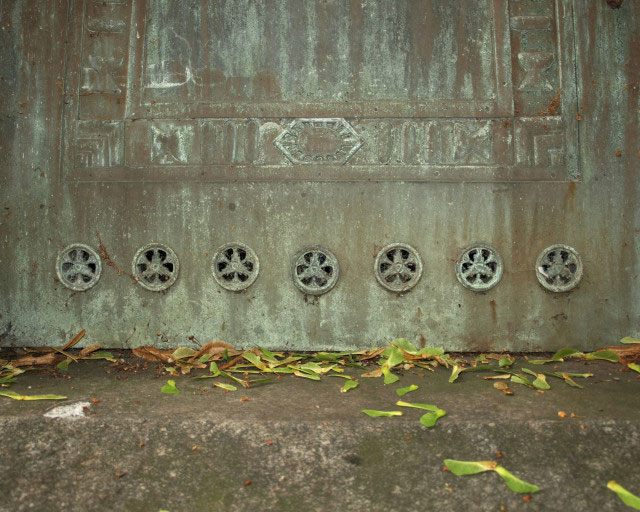
Wheel motifs on Brompton Cemetery’s Courtoy tomb – are they components of a time machine? (Photo: Dead Good Travel)
A mausoleum like this must have cost a huge amount of money and we must ask where Hannah got it from, especially as she started life at a humble level, working as a servant and barmaid. Also, we might wonder exactly how Bonomi and Warner are said to have collaborated with regards to the strange tomb and the weird machine it supposedly contains. Read on and we’ll try to find out.
The Unusual Life and Strange Egyptian Obsessions of Hannah Courtoy
Hannah Courtoy was born Hannah Peters, most sources say in 1784. She left home young, escaping an abusive father, and worked as a housekeeper and in taverns. In 1800, a friend introduced her to John Courtoy, a 70-year-old man in bad health. Of French descent and originally a wigmaker, Courtoy had made an enormous fortune from lending money. He appointed Hannah his housekeeper and a close relationship soon developed between the two. The sources are unclear about what Courtoy’s malady was, but some hint it had been caused by a psychological trauma triggered by a prostitute slashing at him with a knife.
Whatever effect this incident had on Courtoy’s physical health, it appears – at least – to have had a lasting mental impact, making him antisocial and taciturn. He warmed to his young housekeeper, however, and – within a year of entering his employment – Hannah gave birth to the first of what would be three daughters. Hannah always claimed the daughters were John Courtoy’s and she took his name though they never married. Some, however, suspecting Hannah of gold-digging, believed the friend who’d introduced her to Courtoy – one Francis Grosso – had fathered the girls.
Despite managing to get closer to the grumpy Courtoy than anyone else, Hannah still struggled with living with a man who could be profoundly unpleasant. She appears to have escaped into the fascinating world of Ancient Egyptian civilisation and myth, topics which obsessed many Georgians and Victorians. The colonial opening up of Egypt by the British and French and advances in archaeology fuelled these fixations. In 1877-8, the almost-3,500-year-old obelisk Cleopatra’s Needle was shipped to London stand next to the Thames. Plundered objects filled the British Museum while newspapers were full of the exploits of archaeologists and – sometimes – the curses placed upon them by the angry Pharaohs whose tombs they broke into. One particularly outlandish story had a mummy’s screaming ghost haunting not only the British Museum, but also a nearby London Underground Station the spook accessed via a secret tunnel. Another strange episode had an English doctor attempting mummification himself, turning a Manchester heiress into a mummy that ended up exhibited in one of that city’s museums. Egyptian motifs appeared on products as diverse as jewellery and furniture, Egyptian themes invaded operas and novels, and miniature pyramids even popped up in British graveyards to hold the remains of eccentric squires and wealthy professional men. Hannah – like so many of her compatriots – appears to have become more and more engrossed with the mystical society that once flourished on the banks of the Nile.
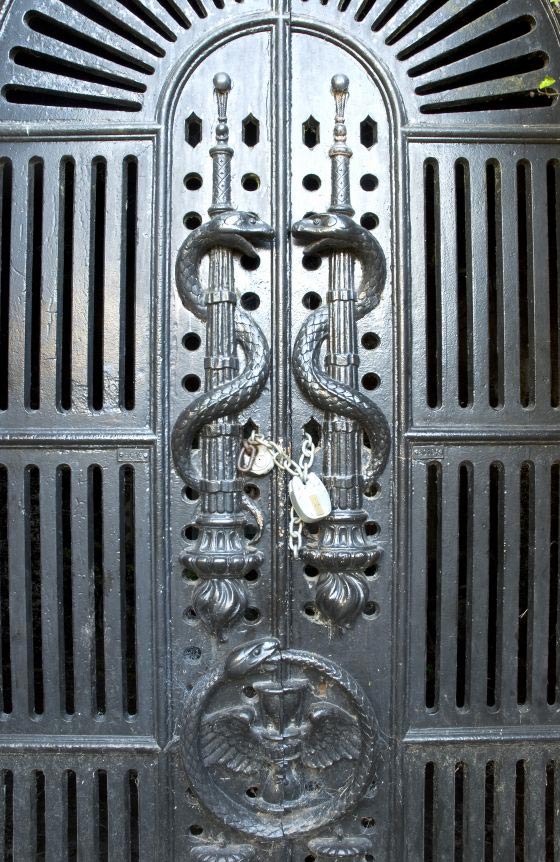
The gates to the catacombs of Brompton Cemetery, London, decorated with the occult emblem of snakes curling around staffs. Note also the memento mori symbols of downward-facing torches and a winged hourglass. (Photo: Royal Parks)
As John Courtoy aged and his health further declined, Hannah seems to have gained more influence over him. In 1810, Courtoy made a will leaving most of his fortune to an ex-wife named Mary Anne Woolley and their five children. This will was amended in 1814 to award Hannah the largest share of Courtoy’s assets. When Courtoy died in 1818, both Woolley and Courtoy’s French relatives challenged the amended will, claiming Courtoy had developed dementia and hadn’t been completely in his senses when he’d altered the document. Court battles dragged on until 1827, but by this date Hannah and her daughters had secured most of Courtoy’s wealth.
Hannah, boosted by her inheritance, lived a lavish life, a life that meant she could indulge even more in her ‘Egyptomania’. Indeed, her wealth and status gave her access to some of those most knowledgeable about Ancient Egypt. Diaries kept by a Courtoy servant, Maureen Sayers, show a regular visitor to the house was the Egyptologist Joseph Bonomi. Hannah and Bonomi soon struck up a friendship and spent hours discussing Egyptian hieroglyphs, religion, magic and astrology. All this led Hannah to conclude the Egyptians had possessed a deep understanding of the cosmos and its workings. One subject Hannah and Bonomi may have dwelled on was time travel. The Victorians frequently speculated that the Ancient Egyptians had knowledge of this art. H.G. Wells’ 1895 novella The Time Machine, for instance, features the motif of the Sphinx. During their lengthy chats about Egyptian lore, the idea seems to have been raised of Hannah funding one of Bonomi’s expeditions. (Cynics might say this could explain the amount of time Bonomi dedicated to his female disciple). The two also arranged for the construction of a 175-foot monument to the Duke of Wellington, a structure they made sure resembled an Egyptian obelisk.
Hannah Courtoy’s friendship with Bonomi continued as the years passed. Many claim Hannah chose him to design her tomb and its Neo-Egyptian style certainly pays homage to their obsessions. The elaborate mausoleum was, however, not ready when Hannah passed away on 26th January 1849 at 14 Wilton Crescent, Belgravia, one of London’s most exclusive addresses. It would be half-a-decade before Hannah’s body could be moved into its final – though opulent – abode. Two of Hannah’s daughters, Mary and Elizabeth – neither of whom married, reputedly because they didn’t want men chasing their money – joined her in the mausoleum, in 1876 and 1895 respectively. Hannah’s other daughter Susannah – who married the barrister Septimus Holmes Godson – is buried elsewhere in Brompton Cemetery.
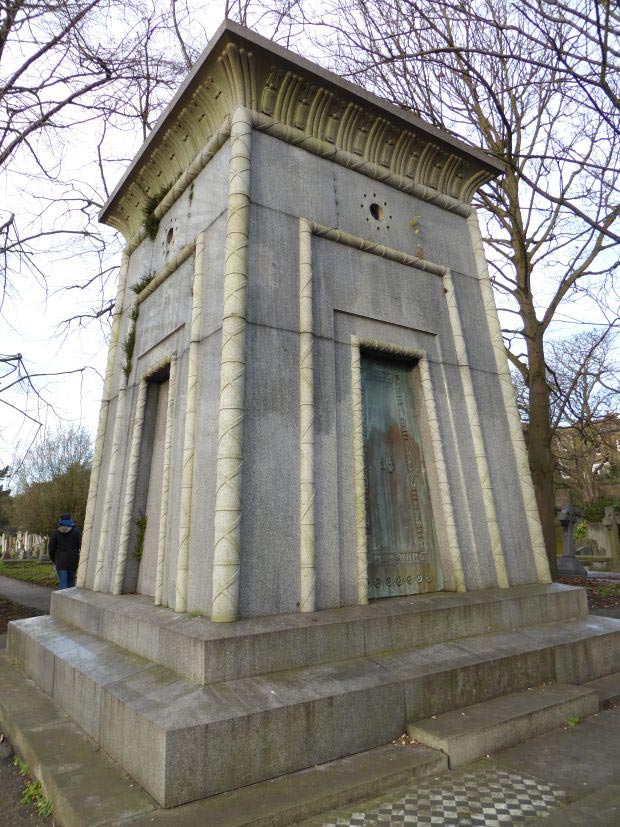
The Courtoy tomb – rumoured to be a Victorian time machine – in London’s Brompton Cemetery. (Photo: Mirella Pastrav)
Mysteriously, no plans of the Courtoy tomb can be found in Brompton Cemetery’s archives: some claim it’s the only tomb for which plans are unavailable. But couldn’t the tomb just be opened so we can know what’s inside? The mausoleum’s key is missing and – as a large key of archaic design would have to be specially made to unlock the tomb – the door cannot simply be opened by a locksmith. Perhaps tellingly, the cemetery authorities seem reluctant to have such a key created. But did Bonomi really design Hannah’s mausoleum? And could the Courtoy tomb really contain a Victorian-Egyptian time machine or teleportation device? To answer such questions, we’ll need to know a little more about the lives of Joseph Bonomi and Samuel Alfred Warner.
Joseph Bonomi the Younger – Did He Deduce the Secrets of Time Travel during His Egyptian Research?
Joseph Bonomi the Younger was born in London in 1796. His father – the unsurprisingly named – Joseph Bonomi the Elder was an Italian immigrant, who grew famous for his skill as an architect and draughtsman and as a designer of country houses. An older brother, Ignatius Bonomi, was also a noted architect.
Joseph the Younger – who would become well-known as a sculptor, artist, Egyptologist and museum curator – began his artistic journey by studying at the Royal Academy. In 1822, he travelled to Rome – his father’s native city – to continue his education there, but after several months found himself in debt. He was rescued by the Scottish antiquarian and Egyptologist Robert Hay, who offered him a modestly paid commission to join an expedition to Egypt. Thus began a lifelong fascination for Bonomi.
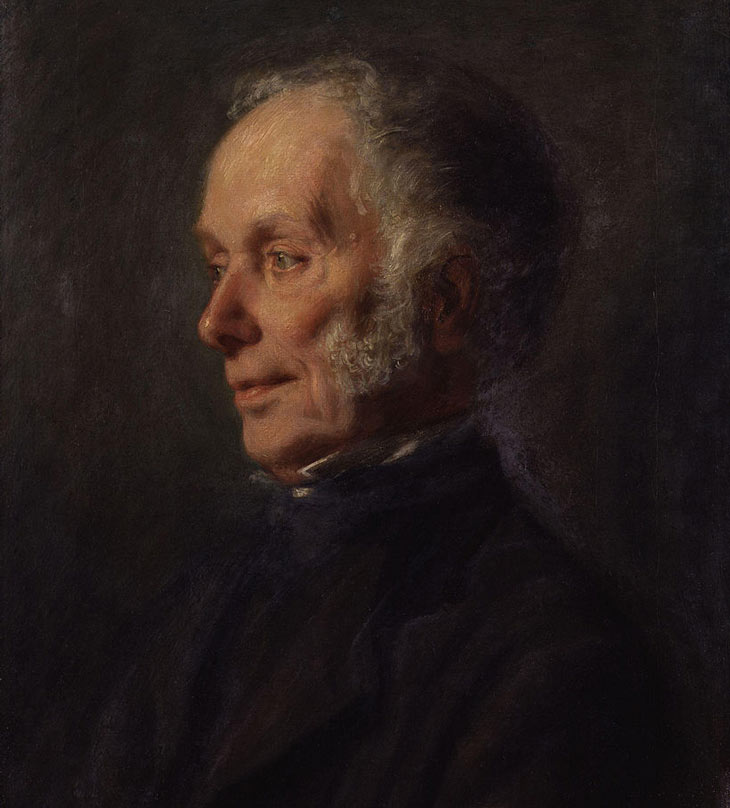
Portrait of the Egyptologist Joseph Bonomi the Younger, by Matilda Sharpe (1868) – did he discover the secrets of time travel?
In Egypt, he sketched antiquities and temple interiors, even inventing a kind of drawing-frame-cum-viewfinder to record such ancient remains more accurately. Bonomi also produced plaster casts of the reliefs of the famous temples of Kalabsha. After two years with Hay, Bonomi – resentful at his low salary – fell out with him. He stayed in Egypt, however, living in Cairo, where he illustrated the pioneering Egyptologist James Burton’s Excerpta hieroglyphica. His finances restored by such work, Bonomi re-joined Hay in 1832 and – after a couple more years in Egypt – undertook tours of Syria and Palestine. In 1839, he contributed illustrations to Manners and Customs of the Ancient Egyptians by Sir John Gardiner Wilkinson, a man described as ‘the father of British Egyptology’.
Upon his return to England, Bonomi followed his family tradition by branching out into architecture. He co-designed the entrance to Abney Park Cemetery, ensuring the gateway was built in an Egyptian style, complete with hieroglyphs signifying the graveyard was ‘the Abode of the Mortal Part of Man’. Bonomi masterminded the famous Egyptian facade for the Temple Works flax mill in Leeds, which opened in 1841, and in 1850 he designed an ‘Egyptian spring’ at Hartwell House, Buckinghamshire, for the mathematician, antiquarian and numismatist Dr John Lee. Between 1842 and 1844, he even fitted in another tour of Egypt, this time as part of a Prussian expedition.
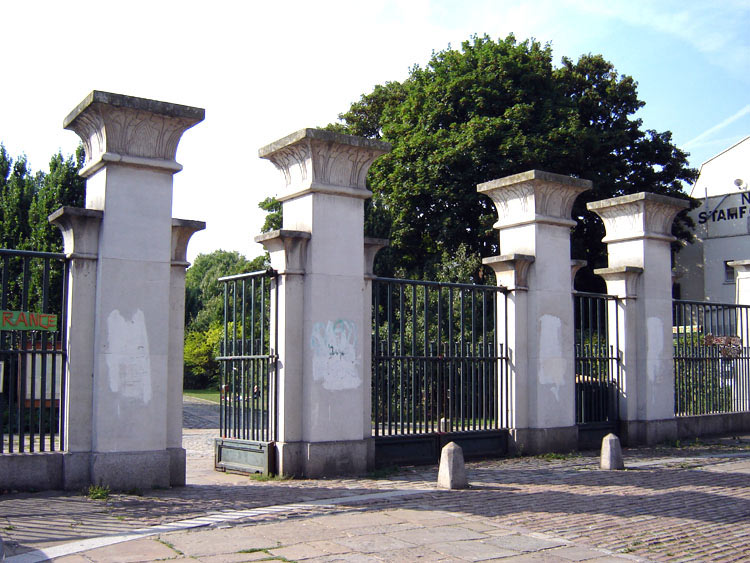
Abney Park Cemetery’s Neo-Egyptian gateway, designed by Joseph Bonomi the Younger. (Photo: Tarquin Binary)
Bonomi kept up his practice of being an illustrator and was considered one of the most skilled reproducers of hieroglyphs in Britain. He published books on Egypt, Nubia and Ethiopia illustrated with his own drawings and wrote well-received works on obelisks and other Egyptian monuments. He also compiled and illustrated many Egyptian collections, including that of the Egyptologist Samuel Birch, who produced a hieroglyphical grammar and dictionary and translated The Book of the Dead. Along with the architect Owen Jones, Bonomi set up the Egyptian Court in the spectacular Crystal Palace when – after it had housed the Great Exhibition of 1851 – it was rebuilt in Sydenham, South London, in 1854. Bonomi also helped arrange the Egyptian exhibits in the British Museum and became the curator of the Sir John Soames Museum in 1861. Joseph Bonomi the Younger died in March 1878 and was laid to rest in Brompton Cemetery.
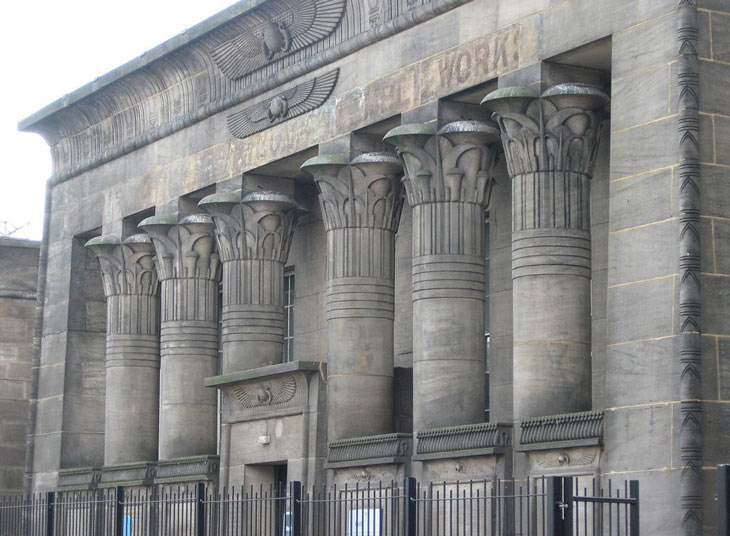
The Neo-Egyptian Facade of Temple Works flax mill in Leeds, designed by Joseph Bonomi the Younger. (Photo: Sarah Grice)
So Joseph Bonomi had a profound understanding of hieroglyphs and Ancient Egyptian culture and had worked closely with many of Britain’s leading scholars of Egyptology. He’d also proved himself as a architect of Neo-Egyptian buildings. It’s therefore entirely possible that Hannah Courtoy would have asked him to design her mausoleum and that – as he was close to her – Bonomi would have accepted the job. While we don’t know if this is what took place, those who argue there’s a connection between Bonomi and the Courtoy tomb point to an intriguing detail on Bonomi’s own headstone.
Bonomi’s tombstone is fairly modest, certainly in comparison to the lavish Courtoy mausoleum. At its top are the Christian symbols of a cross and the Greek letters alpha and omega, but further down things get a lot more Egyptian. Towards the stone’s foot is an engraving of the Egyptian deity Anubis, the jackal-headed god of death, mummification, embalming, tombs, cemeteries and the afterlife. There are two intriguing things about the depiction of the deity. One is that the god is facing in the direction of the Courtoy tomb. The other is that Anubis is positioned on some sort of structure or plinth. Some have remarked on this edifice’s similarity to the Courtoy mausoleum. While the dimensions of Anubis’s plinth don’t exactly match the trapezoid shape of the Courtoy tomb, you have to admit – if you allow just a little imagination to colour your thinking – that the resemblance is curious to say the least.
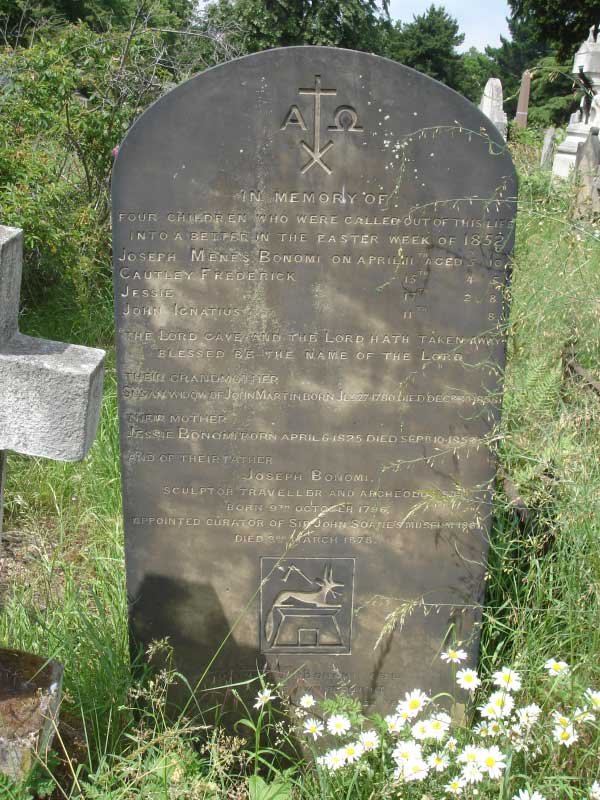
Joseph Bonomi’s gravestone in Brompton Cemetery – note the depiction of the Egyptian god Anubis: is he looking towards the Courtoy tomb? (Photo: Edward Hands)
But what of the more outlandish notion that Bonomi – while deciphering hieroglyphs – stumbled upon the secrets of time travel and helped build a time machine that he hid in the tomb? And if he did make such a bizarre discovery, how might Bonomi have transformed this esoteric knowledge into a practical invention? Bonomi – despite his many talents, deep learning and artistic skill – wouldn’t have had the technical know-how to create such a cutting-edge contraption. In fact, no one in Victorian England would have unless they’d managed to crack some of the most difficult scientific puzzles facing humanity and made a technological leap centuries ahead of their time. One name has been proposed for a man who might just have accomplished such things – Samuel Alfred Warner.
Did Samuel Alfred Warner Invent Brompton Cemetery’s Time Machine?
Samuel Alfred Warner was born in 1793 in Heathfield, East Sussex. His father, William, a carpenter, was rumoured to have a sideline in smuggling. Little is known of Samuel’s early life, but by 1819 he appears to have been working with a London chemist on an explosive. For some time, he served King Pedro I of Brazil and on returning to England managed to capture the interest of King William IV with claims he’d invented secret weapons.
From around 1830, Warner maintained he’d produced two startling innovations. One was what he termed an ‘invisible shell’, a kind of high explosive underwater mine or torpedo ‘no bigger than a duck’s egg’. The other he called the ‘long range’, which, it appears, was a balloon that dropped the ‘invisible shells’ automatically. Warner seems to have attempted an unsuccessful trial of these weapons in collaboration with Charles Green, a pioneering hot air balloonist.
Undeterred, Warner pressed on, conducting a demonstration on an Essex lake that was watched by the prime minister Sir Robert Peel – a demonstration that saw a boat blown up. The government were intrigued and committees were appointed to look into Warner’s inventions. The problem was that, when questioned by the committees, Warner refused to reveal any details of his gizmos until he’d been assured of a payment of £200,000 for each, a staggering sum for the time. Warner – seen by many as a charlatan today – further complicated matters by claiming that during the Napoleonic Wars he’d served under his father on a ship chartered by the British government for espionage purposes and that he’d destroyed two enemy vessels using his inventions. He provided no proof for this narrative, which was marred by anachronisms.
Nevertheless, a further trial of Warner’s devices was arranged, in the English Channel off Brighton in 1844. A substantial crowd watched another ship being destroyed, but officials deemed they couldn’t ascertain what exactly had caused this. Sceptics suspected Warner had attached explosives to an already weakened vessel before the demonstration began. The establishment, however, didn’t lose faith in Warner’s gadgets and in 1852 the House of Lords appointed another committee to examine his claims. After this committee had existed for only one week, though, the Duke of Wellington decided that – as the matter was of military importance – the Ordinance Department should investigate it. The Ordinance Department, however, doesn’t appear to have followed through with any inquiry and official enthusiasm for Warner’s ideas lapsed.
In the early days of December 1853, Warner died in unclear circumstances, leaving a widow and seven children. The fact that he was buried in an unmarked grave indicates he made little – if any – money from his supposedly revolutionary inventions.
So what could connect this offbeat inventor with Joseph Bonomi and Hannah Courtoy and what might link him to the Courtoy tomb and the time machine it allegedly contains? Some say Warner knew or was friends with Bonomi or that for a time the pair were business partners. There’s also the mystery of what exactly Warner’s weapons were capable of. It’s claimed that – as the remote detonation of a bomb would have been impossible with the technology of the era – Warner’s torpedo could have only worked via some kind of teleportation or time slip. This – it’s asserted – Warner achieved thanks to secret knowledge gleaned from hieroglyphs by his friend Bonomi. Funded by Hannah’s fortune, the duo then developed their ideas and constructed a time machine, which they hid in Brompton Cemetery’s Courtoy tomb.
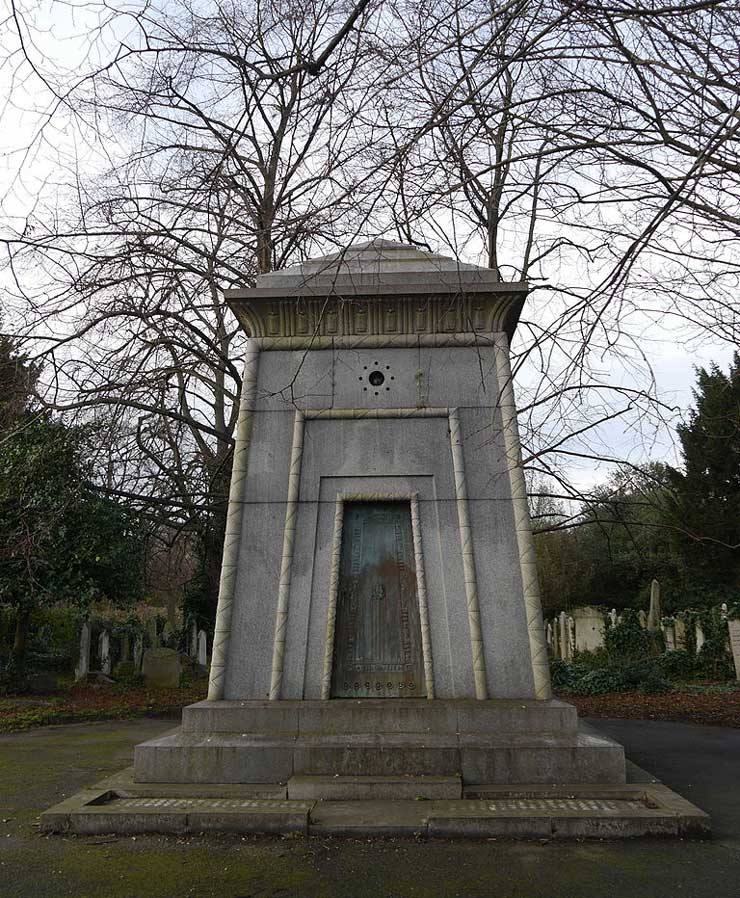
Hannah Courtoy’s Neo-Egyptian tomb in London’s Brompton Cemetery – does it conceal a Victorian time machine? (Photo: Edwardx)
Mythmakers have also seized on the date and unexplained manner of Warner’s death. He died not long after official interest in his theories ended. Might the government have decided his weapons were simply too dangerous to be unleashed on the world or feared them falling under the control of an enemy nation? Could the powers-that-be have therefore murdered Warner to prevent him offering his services to another state or inflicting mass carnage on the planet? Some have even suggested it was Bonomi who bumped Warner off, perhaps out of jealousy or to keep the knowledge of their remarkable invention secret. Others say it isn’t Warner who lies in the unmarked grave – the body in there’s just a decoy and Warner’s actually alive and traversing the aeons in his contraption.
Questions, those fond of a good urban legend assert, do remain. Warner was buried around the time the Courtoy tomb was completed. And Bonomi’s Egyptian-themed headstone was set up not long before Warner’s death. Though Bonomi wouldn’t pass on till many years later, the stone was erected to mark the resting place of four of his children who died of whooping cough in 1852. Might there be more than coincidence here? And why did Hannah’s tomb take so long to finish if there wasn’t some project of great scientific complexity going on? Let’s plunge deeper into this myth and see if we can find any answers to its riddles.
A Teleportation Chamber and the Making of a Surprisingly Modern Myth
It’s been claimed the Courtoy tomb isn’t actually a time machine at all, but rather a teleportation device. This idea was floated most famously in a 2011 blogpost by the London musician Stephen Coates, otherwise known as the Clerkenwell Kid. Coates maintains that teleportation passageways were created to connect the Courtoy mausoleum to tombs with similar designs in London’s other great Victorian graveyards. In fact, all the Magnificent Seven cemeteries were graced with these Neo-Egyptian teleportation buildings. On his blog, Coates provides photos of tombs in Highgate and Kensal Green with resemblances to the Courtoy mausoleum. Another, at Abney Park, is rumoured to have been designed by Bonomi. Coates admits, however, that the ‘teleportation chambers’ in the other cemeteries ‘appear to have entirely vanished’.
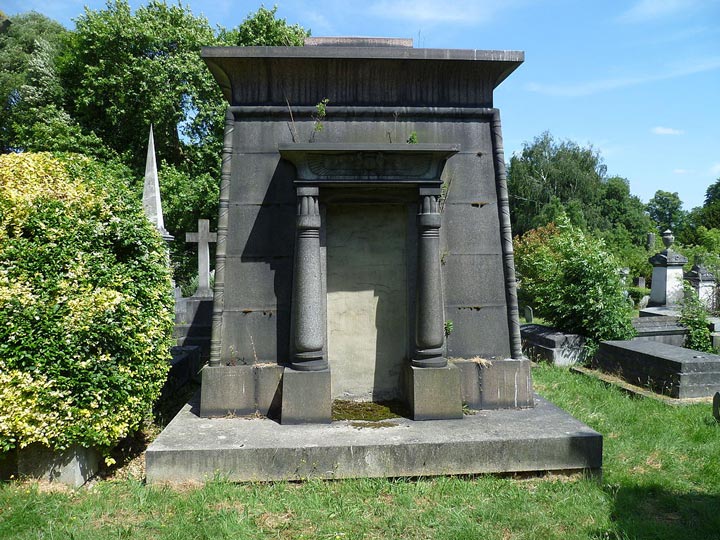
A Neo-Egyptian tomb in Kensal Green Cemetery, London – one of Coates’s alleged teleportation chambers. (Photo: Philafrenzy)
The purpose, Coates claims, of all this teleportation malarkey was to create ‘a transportation grid around London to reduce the time taken to travel the large distances of the vast congested metropolis.’ So, then, a kind of precursor to the London Underground was planned using a hieroglyph-derived method of occult propulsion rather than steam or electricity. Some have taken Coates’s theories further, claiming the metaphysical metro even connects to an Egyptian mausoleum in a Paris graveyard – though it’s uncertain whether this Victorian Eurostar links up with Père Lachaise Cemetery or the burial ground in Montmartre. As for Samuel Alfred Warner’s mysterious demise, Coates feels he may have became ‘lost while teleporting’.
As entertaining as Coates’s blogpost is, I suspect that much of the myth of Brompton Cemetery’s ‘time machine’ grew up from articles like it. An influential article seems to have been one published by the international news agency Reuters on 29th October 1998. This piece, written by Helen Smith and likely with an eye on the upcoming festival of Halloween, features quotes from a little-known author called Howard Webster. Webster states that he began researching the Courtoy tomb after being struck by it while visiting Brompton Cemetery for an unrelated project. The article tells us Webster ‘now believes the twenty-foot-tall building was a time machine built by a maverick Victorian genius, Samuel Warner.’ Webster also makes the now familiar claims that Warner was murdered by the government, that he collaborated with Bonomi and that Hannah Courtoy financed their endeavours. In addition, Webster mentions the engraving of Anubis on Bonomi’s headstone, emphasising that the god is looking towards the mausoleum and that the direction the deity faces also ‘suggests in Egyptian mythology a soul lost out of time.’
Smith’s article also quotes a ‘spokesman at Brompton Cemetery’ called James Mackay, who has a somewhat sober take on Webster’s claims. While Mackay admits it’s possible that ‘some of the papyri they (archaeologists at the time) were decoding dealt with time travel’, he thinks that Warner was ‘an ingenious hoaxer who used tricks to blow up ships for his weapons demonstrations and managed to dupe the Courtoy spinsters into believing he could build them a time machine.’ Mackay does, however, acknowledge that if Warner did believe he was constructing such a device ‘his choice of a cemetery was a shrewd and appropriate one … it was one of the few places where one could work unobserved and where even the most eccentric structures could be explained away.’ Mackay points out that ‘a cemetery where the wealthy and famous are buried is also a location that one could say with great certainty is unlikely to be the subject of redevelopment over time.’ Just like the Egyptian tombs Bonomi imitated, these ‘structures could remain intact over centuries’.
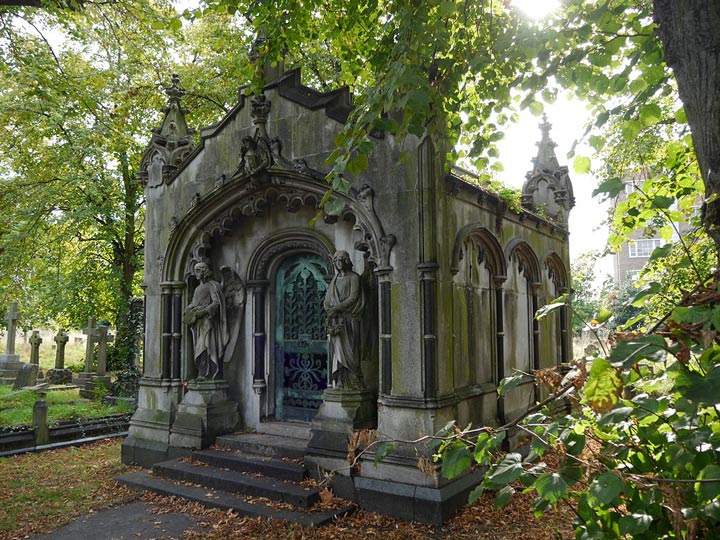
A Victorian gothic mausoleum in London’s Brompton Cemetery. (Photo: Edwardx)
Adding to the mystery, the Reuters article claims ‘there is almost no trace of the Courtoy spinsters. They left no will or other record of their existence, even though the size and opulence of their tomb suggests they were wealthy and influential.’ The article also states the Courtoy mausoleum is the only one in Brompton Cemetery for which no plans can be found, with Mackay remarking ‘the biggest mystery is that you couldn’t build anything in the cemetery without plans and there are no plans’. In addition, Smith’s piece stresses that ‘there is no surviving key’ and that the tomb’s ‘huge bronze door … has not been opened for more than 120 years.’ It also has Webster raising the possibility that ‘Warner’s is not the body in the unmarked grave … I like to believe … he is still alive and travelling through time in his machine.’
I’d suggest this article is the genesis of Brompton Cemetery’s time machine myth. Most of the legend’s central ideas seem to have been arrived at by Webster in his ‘research’. Smith does feature the ‘cemetery spokesman’ Mackay, but it’s not clear from the article if he’s just responding to Webster’s notions or referencing more established folklore. One point he does make, however, is wrong – the Courtoy tomb isn’t the only one in Brompton Cemetery missing its plans. Blueprints are unobtainable for a number of major mausoleums. Likewise, it isn’t in any way exceptional for the keys of old tombs to be lost. The article’s assertion that the Courtoy’s left no will is also incorrect – Hannah Courtoy’s will can be found in the National Archives and is even available online. And I haven’t been able to find any trace of the writer Howard Webster anywhere else despite a thorough trawl through the internet. It’s my suspicion that Webster, an obscure author – having seen the unusual tomb and discovered that a famous Egyptologist and erratic inventor were buried nearby – concocted most of the, admittedly impressive, legend during the 1990s. Popularised by Smith’s widely read article, the myth become a piece of accepted London folklore and others over the years embellished it.
Many of these embellishments, while quaintly fascinating, can also be discounted. The idea that the circular motifs carved into the door’s bottom are components of the time machine is highly questionable. Such indentations are common in Victorian mausoleums – a means of allowing any foul vapours to escape the tomb, thereby preventing gases building up to dangerous levels. As for the ‘crystals’ and ‘dials’ set in the stone near the top, the glass could simply be decoration and the smaller holes also openings through which the fumes of decomposition could disperse.
The ‘missing key’ may have been lost as late as 1980 – some suggest during a visit by Hannah’s descendants though it’s unclear whether they went inside the tomb. The reluctance of the cemetery to replace it is probably down to the fact that having such an implement forged by an expert artisan would be quite an expense, especially for a graveyard full of ancient and precious monuments that must be maintained. The exterior of the Courtoy Mausoleum was, however, repaired in 2009 as frost-cracked chunks of granite had started dropping off the sides.
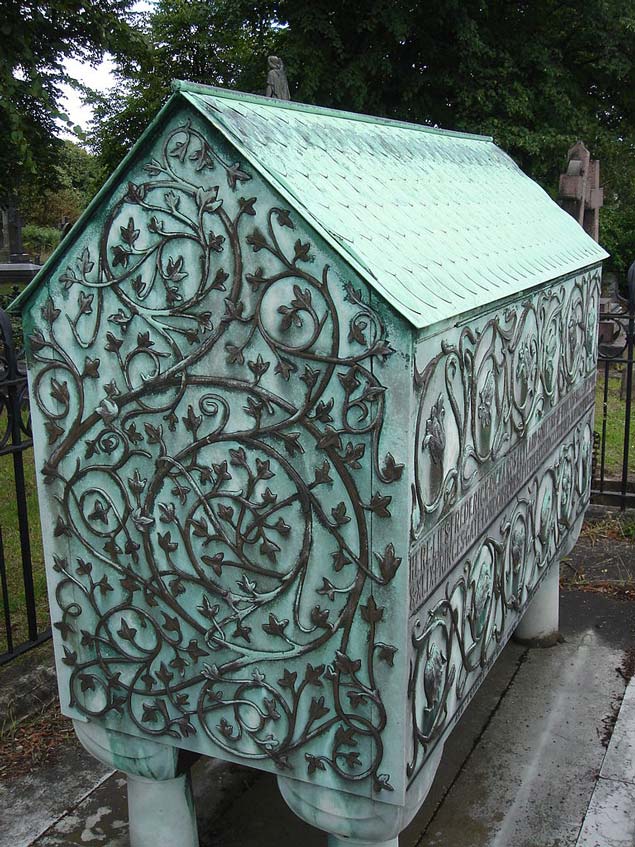
The Arts-and-Crafts tomb of Frederick Richards Leyland, in the style of a medieval reliquary, Brompton Cemetery. (Photo: Edwardx)
Fresh attention was focused on the Courtoy tomb and its legend when the mausoleum featured on the cover of a 2003 album by the Scottish Musician Drew Mulholland, who records as Mount Vernon Astral Temple. The cover of the album – entitled Musick that Destroys Itself – shows an spooky vortex radiating from the tomb’s entrance. Stephen Coates’s popular blogpost then added more to the myth. Interestingly, in his post, Coates suggests the Courtoy tomb inspired Dr Who’s Tardis – an intriguing idea for which there’s, unfortunately, no proof. For anyone, however, looking at the tomb and knowing its legends, the realisation it resembles some stone-walled Tardis must inevitably spring to mind. As for his concept of the seven Victorian-Egyptian teleportation chambers, Coates – while admitting he ‘came up with the whole teleportation system as the background to a short story’ – prefers to characterise his idea as an ‘alternative theory based on historical fact’. Maybe there’s just something about creepy Victorian graveyards and their tendency to generate weird folklore – it’s been rumoured, for instance, that vampires have lurked in both Highgate Cemetery and Glasgow’s Southern Necropolis.
Enthusiasm for Brompton Cemetery’s myth shows no sign of abating. For those with an inclination towards the gothic, the cemetery runs moonlight tours, which inevitably stop at the tomb-cum-time-machine. Storytelling sessions have also been organised at the graveyard, by Coates and the storyteller Vanessa Woolf. The money raised will go towards the funding of a key by which the mausoleum could be opened as well as contributing to renovation efforts in the cemetery. The first event took place in 2015 and, Woolf says, ‘We were absolutely overwhelmed with bookings.’
‘There’s a huge interest in the story in London,’ Woolf told the website Mental Floss. ‘This is a story rooted in the secret, in the occult, but no one is quite sure what actually happened.’
But what if a new key could be fabricated? Woolf said, ‘It’s much nicer in a way not having it. It’s all really in the minds of the audience. It’s a slab of rock. The real magic is in their minds.’
Coates, while eager to get a look inside the tomb, still feels that ‘opening it may not establish it’s not a time machine. It may just deepen the mystery.’ He indeed suspects – even if the tomb’s interior proves to be that of an ordinary mausoleum – the really interesting stuff might be concealed in a secret subterranean chamber. Getting access to that would be the next step.
(This article’s main image – of the Neo-Egyptian Courtoy tomb in London’s Brompton Cemetery – is courtesy of Edwardx.)
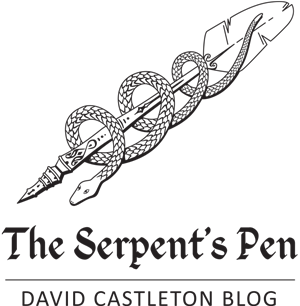
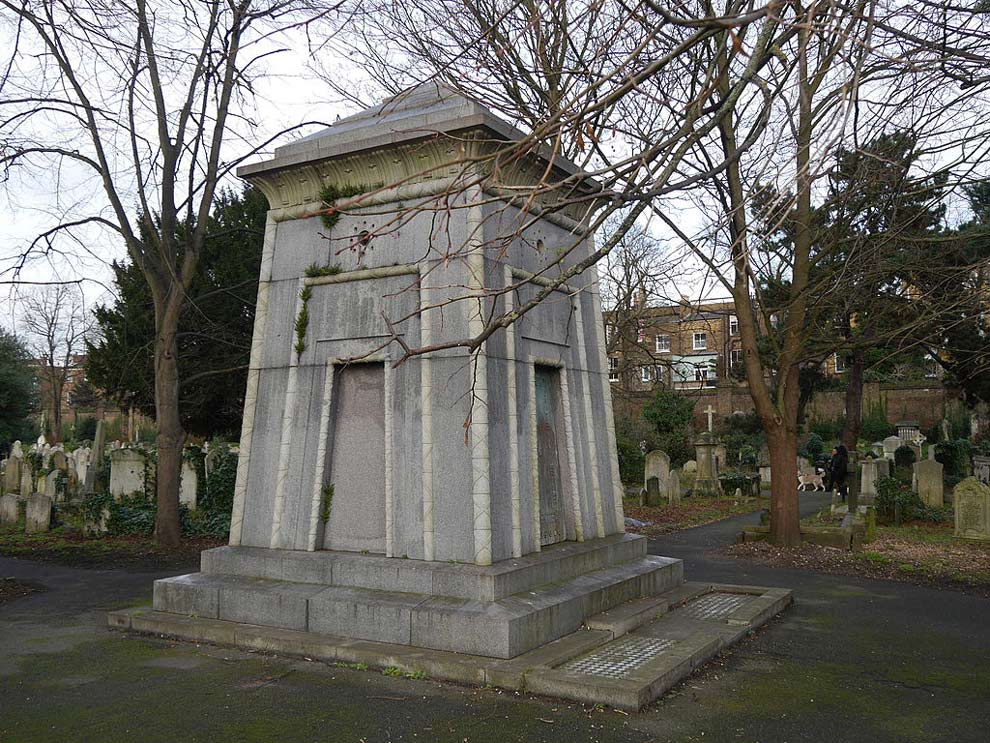
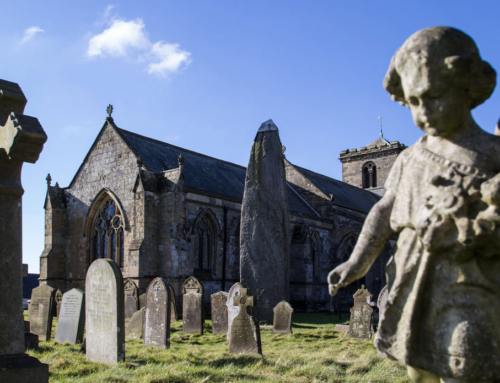

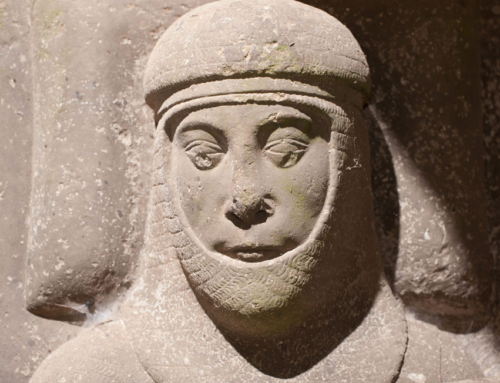
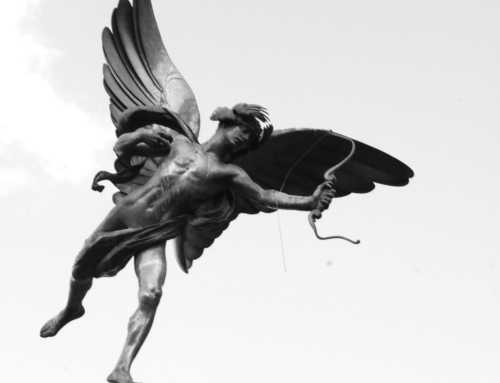
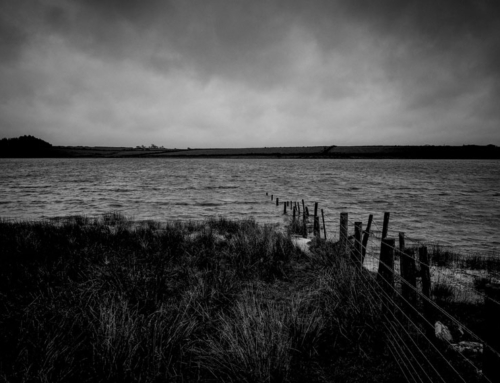
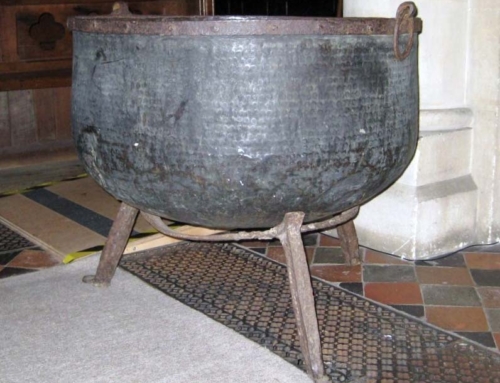
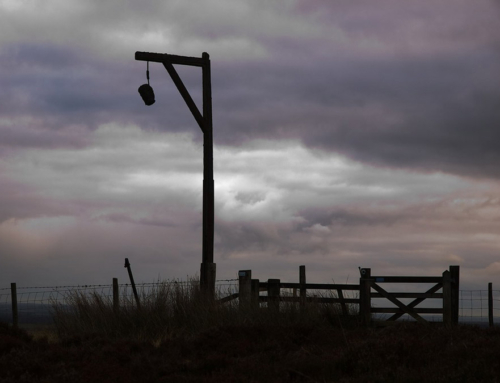
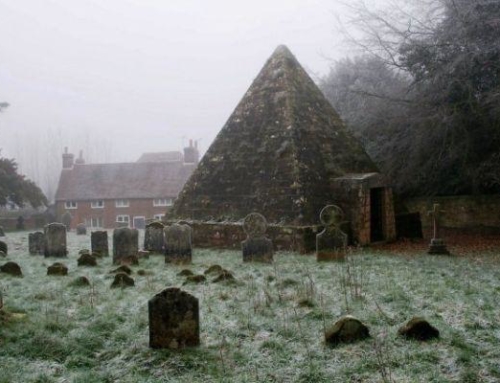
Brilliant.
Inspiringly written and argued.
Many thanks, Gene, glad you enjoyed the tales of Brompton Cemetery’s very own Victorian-Egyptian time machine.
I have visited the Time Machine several times. Upon examining the lock, it appears to have a key in it. But locked from the inside. How this was done I have no theory.
Very very interesting, planning a visit there soon.
Glad you enjoyed the article, Jane. I’m sure you’ll enjoy your visit. I think there’s quite a bit of interest in Brompton Cemetery in addition to the time-travelling Courtoy Mausoleum!
Hi, Brompton cemetery looks very interesting, I keep meaning to take a closer look at Brookwood Cemetery, just down the road from me. It still has a railway station, which conveniently stops right next to the graveyard, handy for speedy transportation of corpses. Which was why it was built, I believe….
I was a firm unbeliever in anything “unnatural/supernatural/ etc) until I was sitting next to somebody eating breakfast, and she turned a whiter shade of pale…
The most disappointing aspect was, I saw nothing….
Yes, we were in an old house, built over the remains of a monastery, with a holy well in the cellar.
Yes, it was owned by a musician.
No, we were not on drugs…… it was 7am after all….
Anyway, she couldn’t speak and was severely shocked….. I took to putting a chair in front of my bedroom door after that… As if that would have helped…!
So, always open to ideas…
Ps… Their chauffeur used to sit in a barn clutching a scythe…. Really
Some fascinating stories there, Jane. Brookwood Cemetery has a very interesting history – it was specifically designed to take corpses from London, shipped out by railway (it had its own railway station) in an attempt to ease overcrowding in the capital’s burial grounds. I’ll probably write a blogpost about it one of these days.
An interesting precedent for this mausolelum is the tomb of the extraordinary Gaspard Monge in Père Lachaise Cemetery in Paris. Links to the French revolution, and the elite freemasons, the Ordre Sacré des Sophisiens are also interesting. Considering the Franco British split of the IPR and artefact post the battle of Alexandria would link Bonomi and Monge. The links with Freemasonry may have helped avoid a bloody copycat revolution in Britain. Another precedent is the mausoleum Francis Jack Needham(aka ‘Black Jack’ Kilmorey) had built for his mistress Priscilla Hoste, originally intended for the opposite plot to Hannah’s at Brompton .
Rumour has it Hannah Peters Courtoy was a Morganatic wife of the House of Hanover, she appears to have owned a chest of Gold Louis D’Or coins, independantly of John Courtoy’s wealth (The genesis of which is closely linked with the Birth of ‘The British Empire’ via the British East India Company, in which he was a major shareholder), and possibly the two elder daughters interred with her may have issued from that relationship, and they (Despite being considerably more comely than their younger ‘half’ sister Susannah) may have been been forbidden to marry on pain of losing a royal stipend. This would help explain why the bulk of Courtoy’s wealth went straight to Susannah, while mother and elder sisters continued to live in independant royal style. Translation of the Hieroglyphs on the mausoleum possibly also supports this hypothesis. H.P.’s subsequent cohabitation with J.C. may have allowed her to maintain a semi-respectable position post parting ways with the House Hanover, on condition of bearing the aging J.C a child….
The key was not lost, but was returned to it’s rightful owner …;)
Wow, very interesting, thank you – the more you look into it, the more intriguing this labyrinthine story gets.